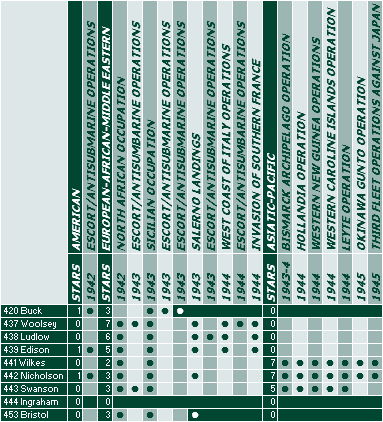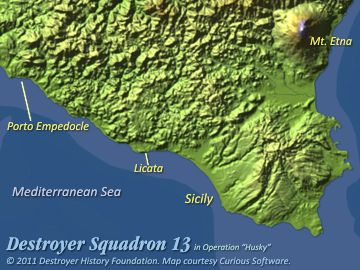
The FY 1940 ships were launched at about the same time as the first Gleaves were placed in commission. When the latter showed that the design was top heavy, the new Gleaves of DesRon 13 were modified, retaining ten torpedo tubes but landing their No. 3 5-inch mounts while increasing their .50 caliber machine gun armament to twelve guns.
Before the United States joined World War II, DesRon 13 operated on the North Atlantic neutrality patrol. It continued operating in the Atlantic in 1942 and sustained two disasters.
World War II operations of destroyers
originally attached to Squadron 13

The other nine ships were present in November for Operation “Torch,” the invasion of North Africa. With Bristol as flagship, with Woolsey and Edison, with Tillman, Boyle and Rowan, screened transports and Wilkes, Swanson and Ludlow, with Murphy attached provided control and fire supprt. On D-day, the 8th, after a gun duel between Massachusetts and Jean Bart, six Vichy French detroyers sortied and Wilkes, Swanson, Bristol and Boyle engaged. Gunfire from Wilkes drove Milan aground before the action subsided. Ludlow was hit by a 6.1-inch shell. Off Casablanca on the 16th, Woolsey, Swanson and Quick sank U-173.

DesRon 13 at Sicily, July 1943.
In 1943, Buck returned in December and in 1943, the squadron moved to the western Mediterranean. There with Roe replacing Ingraham for Operation “Husky,” the invasion of Sicily in July, DesRon 13 formed the destroyer screen for RAdm. R. L. Conolly’s Task Force 86, cruisers Brooklyn and Birmingham and the “Joss” force tasked with seizing the port of Licata. In heavy weather the night before the landings, while maneuvering to avoid a minefield off Porto Empedocle, Swanson and Roe collided. In the morning, Woolsey and Nicholson provided fire support and smoke screens using 5-inch white phosphorous projectiles that hid landing craft from shore batteries. Licata was secured by the end of the day.
In September 1943, the remaining ships of the squadron less Wilkes and Swanson participated with DesRon 7 in Operation “Avalanche,” the invasion of Italy at Salerno south of Naples. Unlike Sicily, the Army insisted that tactical surprise precluded preliminary bombardment—a mistake.

DesDiv 25 at Salerno, September 1943.
Operating with the Southern Attack Force landing at Paestum on D-day, the 9th, DesDiv 25 became immersed in a desperate struggle to prevent German defenders from pushing troops back into the sea. After following cruiser Philadelphia through a minefield to maneuver within as little as a mile of the beach, Edison exchanged point blank fire with Tiger tanks, knocking out twelve. She departed the area with her 5-inch ammunition exhausted and her gun barrels glowing white hot.
The squadron lost two more ships in October. On the 9th off Salerno, U-616 torpedoed and sank Buck with heavy loss of life. On the 12th off Cape Bougaroun, Algeria, U-371 torpedoed and sank Bristol, which was escorting a convoy. Some vengeance came, however: on 16 December 1943, Woolsey and Trippe sortied from Mers-el-Kébir, Algeria to sink U-73 as did destroyers from DesRon 10 and DesRon 7 on 14 May 1944 to sink U-616.

DesDiv 25 at Anzio, January 1944.
In January 1944, DesDiv 26—Wilkes, Nicholson and Swanson—went to the Pacific, where it formed Destroyer Division 24 with Grayson, the lone remnant of DesDiv 22.
Throughout 1944, DesDiv 25—Woolsey, Ludlow and Edison—remained in the Mediterranean, where they operated again with DesRon 7 in Operation “Shingle” off Nettuno, Italy in January. After the landing on 23 January, troops faced a stalemate. Edison distinguished herself by providing fire support for inland positions near Littoria on the 28th, but it took three months before the offensive toward Rome got under way.
DesDiv 25 operated with DesRon 16 in operation “Anvil” off southern France in August. Woolsey, Ludlow and Edison thus became three of only five US Navy destroyers (with DesRon 16’s Parker and Boyle) to complete a “circuit” of all five major landings in North Africa and the Mediterranean. Flagship Woolsey was later awarded the Navy Unit Commendation for her performance in shore bombardment and fire support—a distinction shared only by DesRon 7’s Hilary P. Jones.
In early 1945, the three destroyers of Division 25 left the Mediterranean Sea for the last time. In the summer, they went to the Pacific to convoy occupation troops to Japan.
Source: Destroyer History Foundation database, Dictionary of American Naval Fighting Ships, Roscoe and Morison.